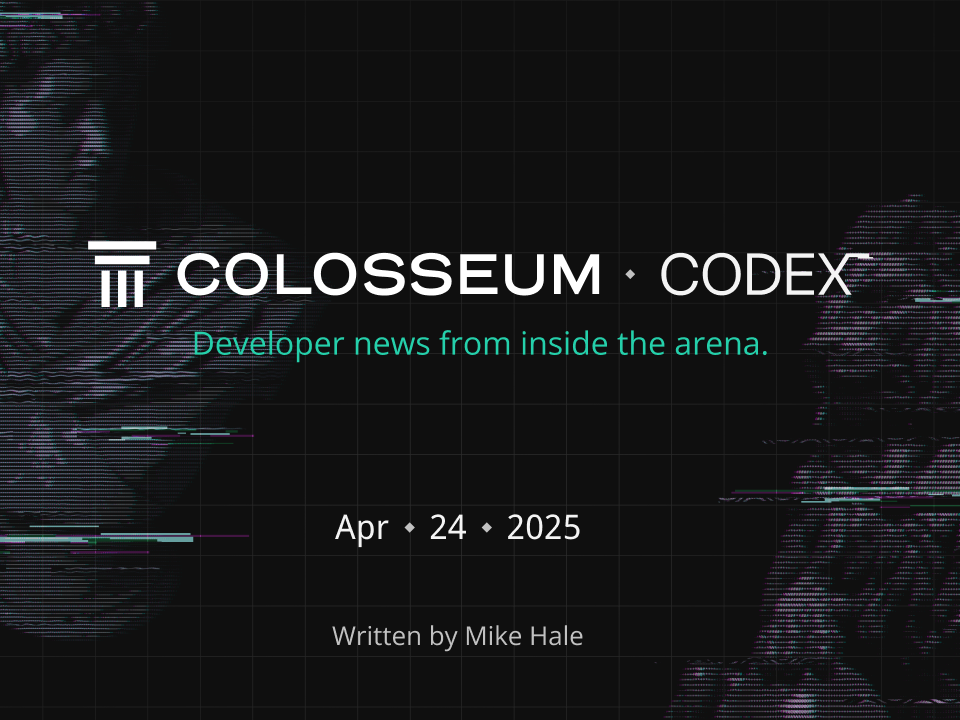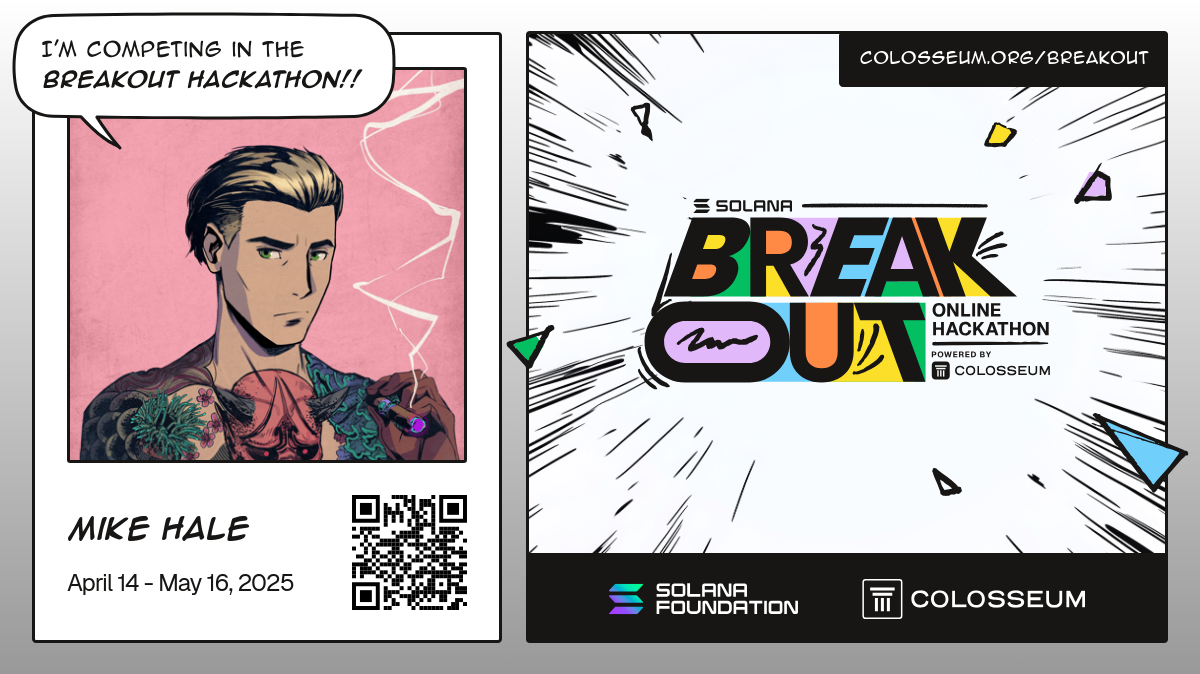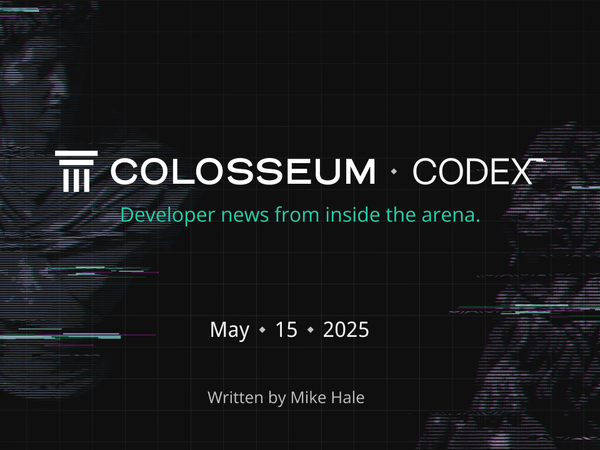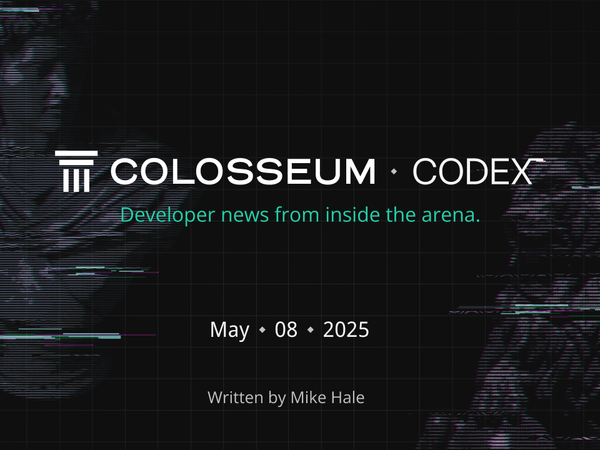Colosseum Codex: FAT Protocol, Multidimensional Transaction Fees, MESA
F.A.T. Protocol Engineering, Multidimensional Transaction Fees, Multiple Election Stake-Weight Aggregation, The State of the Solana Ecosystem

The Breakout Hackathon is heating up and teams are already blowing up the timeline with their progress! We've added a way to share your excitement too with personalized Participation Card like this:

To get yours just go to your Hackathon Dashboard and click the Share link on the header to let others know you've entered the arena!
Now here's the rest of what's new for Solana builders...
⛓️ F.A.T. Protocol Engineering
Solana is working to become the internet-native capital markets platform, opening access to asset ownership to anyone with a connection.
To achieve this goal, the community is embracing F.A.T. Protocol Engineering, a strategic framework with four pillars: Founders, Apps, and Tokenization and core Protocol development.
- Founders: Prioritizing and supporting the individuals and teams who launch new projects. Examples include Tensor HQ (two founders with a $445 million valuation), Pump.Fun (UK-based trading platform generating $155 million in fees in eight months) and BirdEye (24 million users in 2024). Initiatives like the Colosseum hackathons help discover and fund these founders.
- Apps: Emphasizing the development of consumer apps that generate real economic activity, rather than just infrastructure. In October 2024 Solana apps produced $73 million in on-chain revenue, and 74% of ecosystem funding flows to app teams.
- Tokenization: Accelerating the creation and use of digital representations of assets. Over the past six months some 2.6 million tokens have launched on Solana, while token-backed treasuries doubled to $134 million and stablecoin supply rose 120 percent to about $4 billion.
- Protocol: Continual improvement of Solana’s core infrastructure by projects like Anza, Jump Crypto and Jito to boost throughput, reduce latency and optimize hardware to sustain the growing demands of Solana apps.
By engineering these four dimensions at once, Solana aims to build an Internet-native capital market that’s more accessible, liquid and efficient than traditional venues.
Internet Capital Markets and F.A.T. Protocol Engineering
🧪 Multidimensional Transaction Fees
Solana currently keeps the network in sync by letting every validator measure block size with a single metric: computational units (CU).
A new research paper led by Max Resnick asks whether that one-size-fits-all gauge is leaving real capacity on the table.
The authors imagine every instruction as a recipe that pulls different amounts of CPU time, memory, and bandwidth into one measuring cup. You have to size the cup for the messiest possible recipe.
That safety padding can make ordinary blocks look “full” long before any individual resource is actually maxed out.
The paper introduces a yard-stick, called alpha that tells you exactly how much extra room would appear if each major resource were measured on its own line instead of rolled into one.
Calculating alpha is as simple as feeding real instruction traces into the formula they provide, but once you plug in realistic mixes of transactions, alpha might shrink to a single-digit percentage.
The practical takeaway is straightforward: measure first, then decide.
If your alpha comes back small, Solana’s single-CU system is already doing its job with minimal waste. If it comes back large, adding a second or third meter might unlock more headroom than any code-level optimization.
Either way, this approach gives developers a clear, data-driven way to judge whether multidimensional fees are worth the complexity.
Does Your Blockchain Need Multidimensional Transaction Fees?
🗳️ Multiple Election Stake-Weight Aggregation
Galaxy Research has proposed a new "market-driven" voting framework for Solana's emissions policy, called Multiple Election Stake-Weight Aggregation (MESA), in response to the failed SIMD-228 proposal.
MESA is designed to move beyond the traditional binary (yes/no/abstain) voting system by allowing validators to express preferences across a spectrum of deflation rates.
The final outcome is determined by the weighted average of all votes, provided a quorum is met.
Key features of MESA:
- Validators vote for specific deflation rates rather than simply approving or rejecting a single proposal.
- The chosen deflation rate is the aggregate (weighted by stake) of all votes for different rates, rather than the outcome of a binary vote.
- The proposal does not introduce a dynamic model but continues the current system of annual inflation reduction
- MESA seeks to capture the community’s preferences and avoid the divisions seen in previous votes
The main criticism of the MESA proposal centers on the risk of strategic voting.
Some community members worry that because the outcome is based on the weighted average of all votes, participants might not vote for their true preference.
Instead, they could vote for an extreme option in order to pull the average closer to their ideal result.
Another concern is the complexity the new system introduces.
The binary yes/no voting system, while limited, is easy to understand. MESA, by contrast, requires voters to think strategically about how their vote will affect the average, which could lead to confusion during the voting process.
As an alternative to the weighted average, some have suggested using the median of stake-weighted votes instead. The idea is that the median would be less susceptible to manipulation by extreme votes and would better represent the central tendency of community preferences.
Despite these criticisms, there is general agreement that a broader set of voting options could help capture the nuanced preferences of the Solana community.
Galaxy Proposes New Market-Driven Voting System for Solana Emissions
⭐ Highlights of the Week
Build in Public
Build in Public is a new X Community for Solana Breakout Hackathon builders who want to document their projects openly, swap in-progress code or demos, and receive real-time feedback from fellow builders, mentors, and investors.
Anchor vs Pinocchio
The video builds a simple vault program with both frameworks to show the trade-off between Anchor’s macros and built-in checks for rapid development vs. Pinocchio's raw performance boosts, at the cost of complexity. In short, use Anchor for speed and guardrails and switch to Pinocchio when max performance is the priority.
The State of the Solana Ecosystem
This report is a data-driven study that mines The Grid's Solana dataset to map every active team, product, asset and tooling layer on the network. The report’s goal is to demonstrate, with verifiable numbers, how Solana has moved from a DeFi-centric chain to a broad platform spanning gaming, NFTs, data services and a fast-growing set of AI integrations.
⚡ Quick Hits
Solana Game Pass: The Beginning of the Solana Gaming Supercycle - @GamingOnSolana_
How to Succeed in Solana (video) - Mike MacCana
Solana Global Creator Competition Winners Announced - @littleunusualHQ
The most effective way to learn Solana auditing - @0xjuaan
100 Solana Developer Tips - @r0bre
Crypto APAC GTM Playbook: Navigating the Asian Landscape - @ahboyash
Analysis: The highest-earning DApps on Solana - @Syndica_io
Ranger DEX API integrated into Solana Agent Kit - @ranger_finance
Solana RWA Builder Spotlight - @MetaWealth
⚙️ Tools & Resources
Tokamai Agent (beta) is a multimodal assistant for Solana that provides security reviews, coding help and live user support through chat interfaces with filtered notifications and integrated workflows, built on AI-first principles for crafting prompts, leveraging AI capabilities and enabling human-AI collaboration.
Solana Agent Kit v2 is a redesigned open-source toolkit for building Solana applications with integrated wallet and transaction support, addressing v1’s security and context-bloat issues by replacing insecure private-key inputs and unwieldy tool aggregates with a modular plugin architecture.
Ephemeral Counter demonstrates Magicblock's Ephemeral Rollups (ER) technology on Solana by implementing a simple counter program that can operate on both the Solana base layer and an ephemeral rollup for improved performance.
💸 Funding
Astra Fintech has launched a $100 million fund based in South Korea to support the Solana ecosystem across Asia by investing in projects and forming partnerships with developers, companies and regulators working on PayFi solutions that use blockchain to process payments and integrate traditional finance with digital currency.
RockawayX, an early investor in Solana, has closed a new $125 million early-stage fund to back yield-generating startups building on the Solana blockchain. About two-thirds of the newly established fund will be allocated to seed investments, with the remaining portion held in liquid assets that generate income.
👩🔧 Get Hired
- Solana Foundation is hiring a Lead Software Engineer, Infrastructure and a Solana Rust Engineer to drive development of infrastructure-related projects and onchain programs.
- Anza is hiring a Software Engineer, Networking to fortify Anza's Agave client and the broader Solana network.
- Sphere is hiring a Senior Software Engineer (Spherenet) to to shape, build, and maintain Spherenet.
- Backpack is hiring for multiple developer and engineering roles.
- Raiku is hiring an Infrastructure & DevOps Engineer to drive the performance and scalability of next-generation distributed systems.
- Pulse is hiring a Backend Developer to lead development of the suite of Pulse health apps.
📅 Event Calendar
Breakout Hackathon Workshop: Decentralizing the whole stack with Walrus, April 25, 6pm UTC, Virtual
In this virtual workshop, Daniel Leavitt will introduce Walrus, a decentralized storage network designed to power the next generation of apps and infrastructure. You’ll learn why Walrus was built, how the network works, and see real-world use cases already live today.
Breakout Hackathon: Intro to Game Development on Solana, May 1, 2pm UTC, Virtual
Jonas Hahn from Solana Foundation gives an introduction into all the different game sdks on Solana, why to use Solana for a game, what the benefits can be and live coding a small game that uses a WebSocket connection and auto signing.
🎧 Listen to This
Lightspeed
Matty Taylor discusses the Colosseum playbook, what founders are building, the rise of vibe coding, finding product market fit, and more!
In the podcast, Taylor highlighted the growing interest in privacy preserving applications among Solana developers and pointed to new approaches to DAOs as another area of innovation.
“One of the things that we're most excited about is sort of a return to crypto cypherpunk roots”
He observed that founders are exploring private trading technology and mentioned Darklake, the former Colosseum winner that is building a ZK enabled DEX.
He also noted that builders are creating solutions for private payments on existing stablecoins, reflecting a shift to on-chain privacy, shown further by Helius’ recent launch of confidential balances and Arcium’s encryption infrastructure running on testnet.
Taylor went on to discuss DAOs, acknowledging that while they remain challenging to execute, there are promising new models emerging.
Colosseum was an early backer of MetaDAO, a governance platform driven by market-based mechanisms, and Taylor described a futarchy-enabled token launchpad in which raised funds are held in escrow and released only after token holders use decision markets to vote on spending.
These developments suggest that both privacy features and innovative governance structures are gaining real momentum in the Solana ecosystem.
Accelerating Solana's Startup Ecosystem | Matty Taylor
Bonus Episodes
Akshay BD: Solana, Crypto Marketing, Stablecoins, Tokenization and Ecosystem Growth - Y-Axis Podcast
Tristan Yver and Akshay BD discuss the evolution of stablecoins, the role of foundations in blockchain development, strategies for breaking into the scene, and the technological innovations within Solana.
Austin Federa’s DoubleZero is rewiring the internet to supercharge crypto - The Block
Austin Federa discusses how the current public internet infrastructure bottlenecks blockchain performance, and how DoubleZero looks to address this by leveraging underutilized fiber optic cables to create a dedicated global network to support higher performance.
Follow @mikehale on X or Warpcast!
Thanks for reading ✌️
I hope you found something useful here! If you have any suggestions or feedback just let me know what you think.




